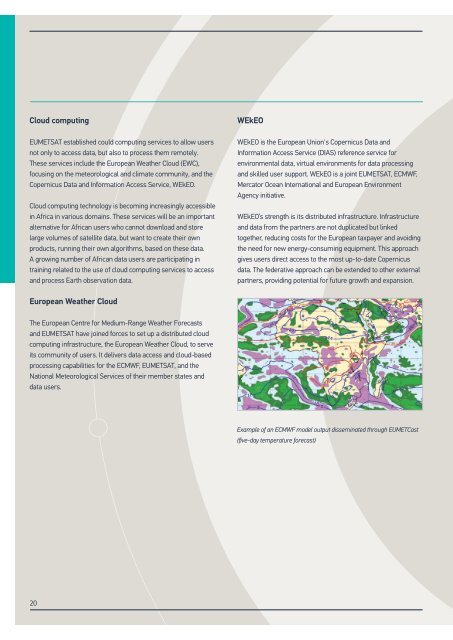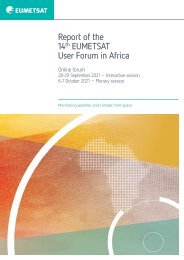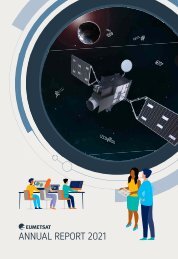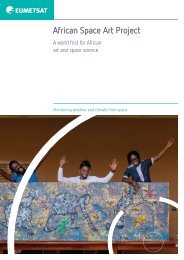EUMETSAT and Africa
European meteorological satellites at the service of Africa
European meteorological satellites at the service of Africa
- No tags were found...
Create successful ePaper yourself
Turn your PDF publications into a flip-book with our unique Google optimized e-Paper software.
Cloud computing<br />
WEkEO<br />
<strong>EUMETSAT</strong> established could computing services to allow users<br />
not only to access data, but also to process them remotely.<br />
These services include the European Weather Cloud (EWC),<br />
focusing on the meteorological <strong>and</strong> climate community, <strong>and</strong> the<br />
Copernicus Data <strong>and</strong> Information Access Service, WEkEO.<br />
Cloud computing technology is becoming increasingly accessible<br />
in <strong>Africa</strong> in various domains. These services will be an important<br />
alternative for <strong>Africa</strong>n users who cannot download <strong>and</strong> store<br />
large volumes of satellite data, but want to create their own<br />
products, running their own algorithms, based on these data.<br />
A growing number of <strong>Africa</strong>n data users are participating in<br />
training related to the use of cloud computing services to access<br />
<strong>and</strong> process Earth observation data.<br />
WEkEO is the European Union's Copernicus Data <strong>and</strong><br />
Information Access Service (DIAS) reference service for<br />
environmental data, virtual environments for data processing<br />
<strong>and</strong> skilled user support. WEkEO is a joint <strong>EUMETSAT</strong>, ECMWF,<br />
Mercator Ocean International <strong>and</strong> European Environment<br />
Agency initiative.<br />
WEkEO’s strength is its distributed infrastructure. Infrastructure<br />
<strong>and</strong> data from the partners are not duplicated but linked<br />
together, reducing costs for the European taxpayer <strong>and</strong> avoiding<br />
the need for new energy-consuming equipment. This approach<br />
gives users direct access to the most up-to-date Copernicus<br />
data. The federative approach can be extended to other external<br />
partners, providing potential for future growth <strong>and</strong> expansion.<br />
European Weather Cloud<br />
The European Centre for Medium-Range Weather Forecasts<br />
<strong>and</strong> <strong>EUMETSAT</strong> have joined forces to set up a distributed cloud<br />
computing infrastructure, the European Weather Cloud, to serve<br />
its community of users. It delivers data access <strong>and</strong> cloud-based<br />
processing capabilities for the ECMWF, <strong>EUMETSAT</strong>, <strong>and</strong> the<br />
National Meteorological Services of their member states <strong>and</strong><br />
data users.<br />
Example of an ECMWF model output disseminated through EUMETCast<br />
(five-day temperature forecast)<br />
20









